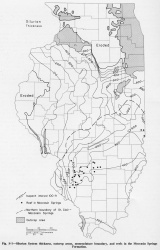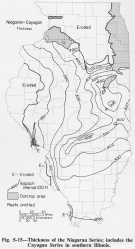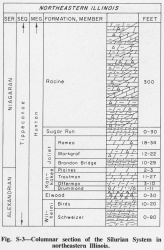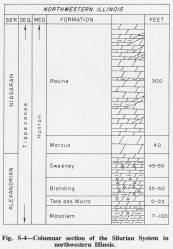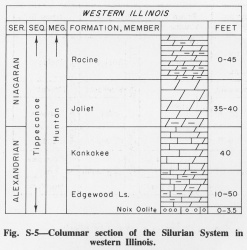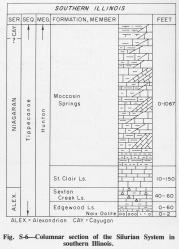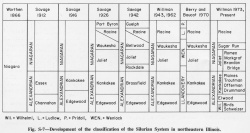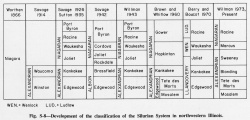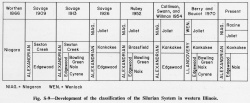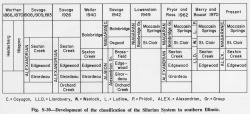Niagaran Series
Lithostratigraphy: Hunton Limestone Megagroup
Chronostratigraphy: Paleozoic Erathem >>Silurian System >>Niagaran Series
Allostratigraphy: Tippecanoe Sequence
Primary source
Willman, H. B., Elwood Atherton, T. C. Buschbach, Charles Collinson, John C. Frye, M. E. Hopkins, Jerry A. Lineback, and Jack A. Simon, 1975, Handbook of Illinois Stratigraphy: Illinois State Geological Survey Bulletin 95, 261 p.
Contributing author(s)
H. B. Willman and Elwood Atherton
Name
Original description
The Niagaran Series (Hall, 1842, p, 57; Swartz et al., 1942, chart 3).
Derivation
Based on the Niagara Falls section in New York, as restricted by differentiation of the pre-Clinton strata as the Alexandrian Series (Savage, 1908, p. 434).
Other names
History/background
Type section
Type location
Type author(s)
Type status
Reference section
Reference location
Reference author(s)
Reference status
Stratigraphic relationships
Niagaran Series strata are overlain by the Cayugan Series only in southern Illinois, where the position of the top of the Niagaran is not definite but at present is placed in the upper part of the Moccasin Springs Formation. Elsewhere in Illinois the top of the Niagaran Series is truncated by Middle Devonian or younger strata.
Extent and thickness
Niagaran strata crop out in all four outcrop areas of Silurian rocks in Illinois (fig. S-1) and are present in subsurface throughout most of the Illinois Basin (S-15). Niagaran strata have a maximum thickness of a little more than 1000 feet in Marion County, where the Sandoval Reef stood high above the surrounding interreef Niagaran (fig. S-11).
Lithology
The Niagaran Series consists of the strata above the Microcardinalia Zone (Stricklandinia or Stricklandia Zone of early reports) up to and including the faunal zone characteristic of the Guelph Formation in New York and Ontario, which is commonly identified as the Megalomus Zone. Three facies were recognized in the Niagaran strata by Lowenstam (1949). A dominantly shaly facies (Bainbridge Group) occurs in the southern part of the state and also surrounds numerous reefs in the northern part of that area. A facies of intermediate purity (Thorn Group) extends from western Illinois to the Chicago region, and in it the reefs are surrounded by cherty, generally silty dolomite. A relatively pure facies (Coe Group) occurs in northwestern Illinois where the reefs are surrounded by dolomite that is generally purer than it is in the other facies. These units are at present recognized as facies, not groups, and different rock-stratigraphic classifications are used within the three facies (figs. S-3 to S-6). The boundary between the southern and northern facies is transitional through a broad zone entirely in subsurface, but, for practical purposes of changing nomenclature, it is placed at the northern boundary of the area in which a distinctive electric log marker, the " two-kick, three-kick zone," can be recognized (figs. S-1, S-16). The position of the boundary of the northwestern facies is not as well known and the rock-stratigraphic units have not as yet been traced far from the outcrop area.
Core(s)
Photograph(s)
Contacts
Well log characteristics
Fossils
Age and correlation
According to Berry and Boucot (1970, pl. 2), the Niagaran in Illinois is equivalent to most of the Upper Llandovery , the Wenlock, the Ludlow, and part of the Pridoli Series in Europe (figs. S-7 to S-10).
Environments of deposition
Economic importance
Remarks
References
BERRY, W. B. N., and A. J . BOUCOT, 1970, Correlation of the North American Silurian rocks: Geological Society of America Special Paper 102, 289 p.
HALL, JAMES, 1842, Geology of the Western States: American Journal of Science, v. 42, p. 51-62.
LOWENSTAM, H. A., 1949, Niagaran reefs in Illinois and their relation to oil accumulation: Illinois State Geological Survey Report of Investigations 145, 36 p.
SAVAGE, T. E., 1908, On the lower Paleozoic stratigraphy of southwestern Illinois: American Journal of Science, v. 25, p. 431-443; expanded in Illinois State Geological Survey Bulletin 8, p. 103-116.
SWARTZ, C. K., et al., 1942, Correlation of the Silurian formations of North America: Geological Survey of America Bulletin, v. 53, p. 533-538.
ISGS Codes
| Stratigraphic Code | Geo Unit Designation |
|---|---|
